Are you captivated by the stunning artistic architecture of the Duomo in Florence? If so, the Florence Duomo Museum (The Museo dell’Opera del Duomo) will undoubtedly delight you.
Now, I don’t consider myself an art connoisseur or history fanatic. To be completely transparent, I only set foot in the Florence Duomo Museum because it was part of my 3-day pass to the Complex of Santa Maria del Fiore.
Surprisingly, that visit became a true highlight of my Florence adventure. The Duomo Museum in Florence left me in awe with its remarkable exhibits and engaging presentations. It’s a museum experience I’ll cherish forever!
Leaving the museum, I felt enriched with a deeper comprehension of the artistic construction methods, materials and refined craftsmanship that molded the Duomo in Florence.
This comprehensive immersion in Florence’s religious and artistic heritage proved to be far more valuable than any leather handbag or miniature sculpture of Michelangelo’s David I could’ve picked up during my trip.
So, take my word for it: Your journey to the Duomo in Florence simply won’t feel complete without exploring the Florence Duomo Museum. It’s an experience you won’t want to miss!
A Home to a Treasure Repository of Rare Artifacts
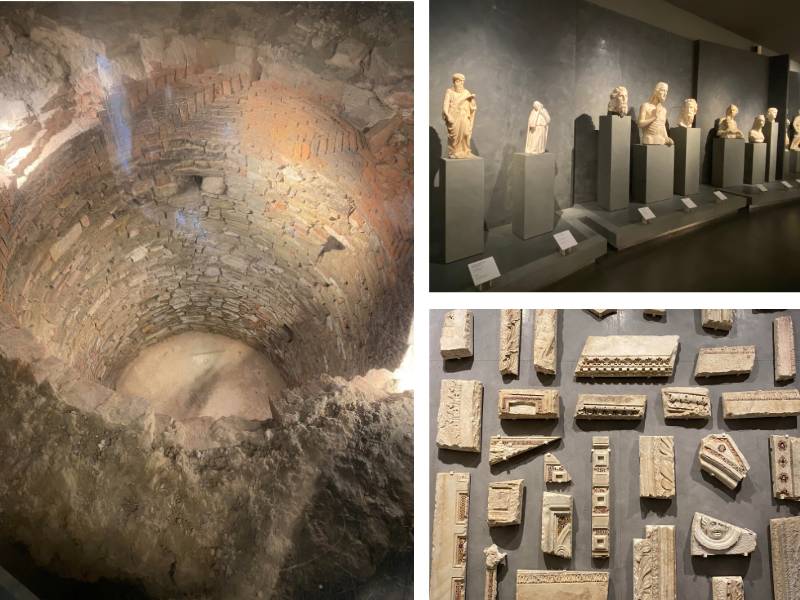
The Florence Duomo Museum draws in over 630,000 visitors annually, and there’s a good reason for it.
Throughout the centuries, numerous exquisite works of art were removed from the Duomo, the Baptistery and Giotto’s Bell Tower. But where did they all end up? That’s when the Opera del Duomo Museum came into the picture. Established in 1891, the museum aimed to protect these masterpieces from pollution and potential damage.
Nowadays, the museum showcases an astounding collection of more than 750 works of art, spanning seven centuries from the Medieval period to the Renaissance. It’s home to the largest concentration of Florentine monumental sculpture and architectural elements in the world, all connected to the Duomo.
In 2015, the Florence Duomo Museum underwent a significant renovation, modernizing its facilities. The museum features three floors and a hidden gem on the rooftop—a terrace where visitors can admire the Brunelleschi Dome from an up-close vantage point amidst a picturesque skyline.
The museum may not be massive, but it’s certainly spacious. Its spaces are thoughtfully designed, well-lit and adorned with informative notes and engaging explanatory videos. Surprisingly, some displays even invite visitors to touch them.
The museum’s contemporary design is truly impressive. It brought to mind other notable modern museums, such as the Caen Memorial Museum and the 9/11 Memorial & Museum.
Humbly nestled in the heart of the city of Florence
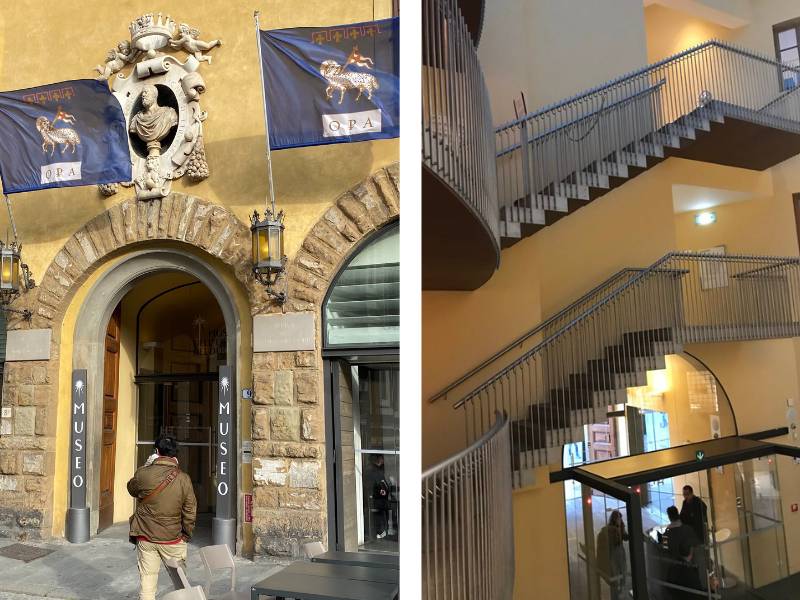
The Florence Duomo Museum is conveniently situated just a one-minute walk from the Duomo itself, as part of the Complex of Santa Maria del Fiore (Saint Mary of the Flower) in Florence.
If you’re not familiar with the Complex of Santa Maria del Fiore, it consists of eight remarkable sites: the Cathedral (Cattedrale di Santa Maria del Fiore or Duomo di Firenze), the Brunelleschi Dome (Cupola), the Baptistery of St. John (Battistero di San Giovanni), the Duomo Museum, Giotto’s Bell Tower (Campanile), the Duomo Terrace, Santa Reparata and a restoration workshop.
Did you know that the area where the Florence Duomo Museum stands today was not only utilized for planning and executing the work on the Duomo, but also served as Brunelleschi’s headquarters during the Duomo’s construction?
And, if that’s not cool enough, it’s also the very spot where Michelangelo carved the famous David statue!
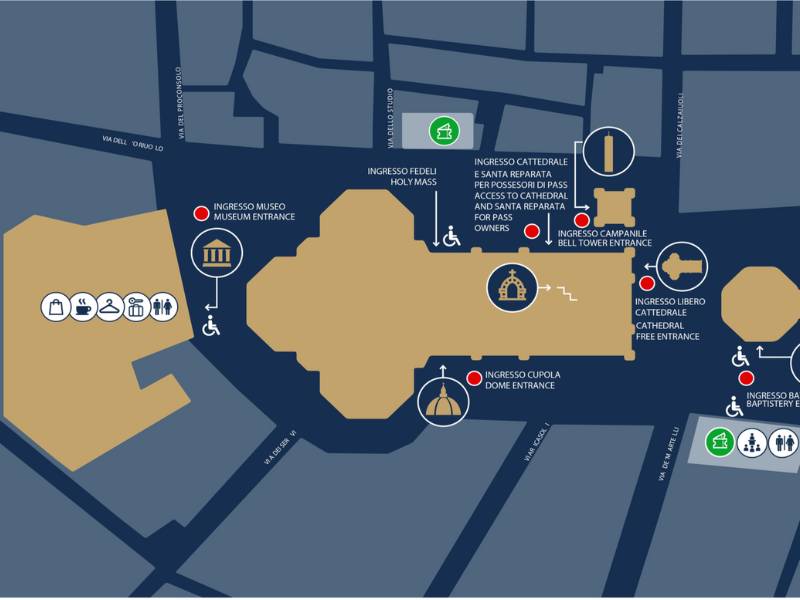
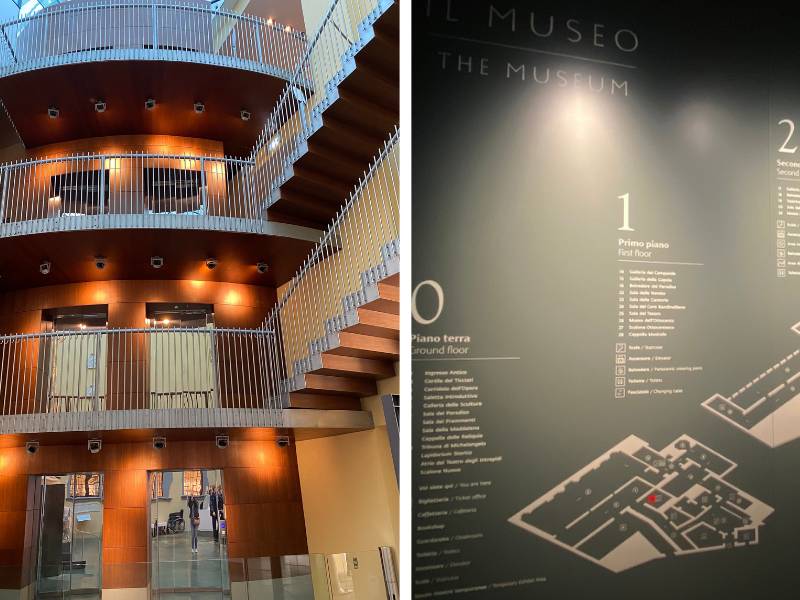
Is it Better to Have an Audio Guide When Navigating the Florence Duomo Museum?
I checked the Duomo’s official website for audio guide rental before my visit, and they informed me that the rental station is at the ticket office in Piazza Duomo, located right in front of the Duomo.
You can rent an audio guide for a full day, with prices ranging from €5 for one monument, €7 for two, €10 for three and €15 for all the monuments. Remember to bring your ID to pick up the audio guide.
The long lines outside the ticket office were a bit intimidating whenever I passed by the Duomo, so I decided not to rent one and see how it would go. When I entered the Florence Duomo Museum, I was immediately struck by the massive, life-size reconstructed original façade of the Cathedral and the grand, 5-meter tall original doors of the Baptistery. At that moment, I felt a twinge of regret for not renting the audio guide beforehand.
However, the museum features informative notes next to the exhibits, and the interactive explanatory boards on the second floor, which are related to all the arts of the Duomo, offer incredibly useful information. Although I didn’t have the audio guide, I still had a fantastic 3-hour journey through the museum.
Top 15 Must-see Highlights in the Florence Duomo Museum
The Duomo Museum in Florence is a true gem, showcasing a wealth of stunning art and intriguing history connected to the Florence Duomo, one of the Renaissance’s most intricate and captivating architectural marvels.
To enhance your experience in this enchanting museum, we’ve put together a selection of 15 unmissable highlights that will lead you through its awe-inspiring masterpieces.
The cathedral’s original façade
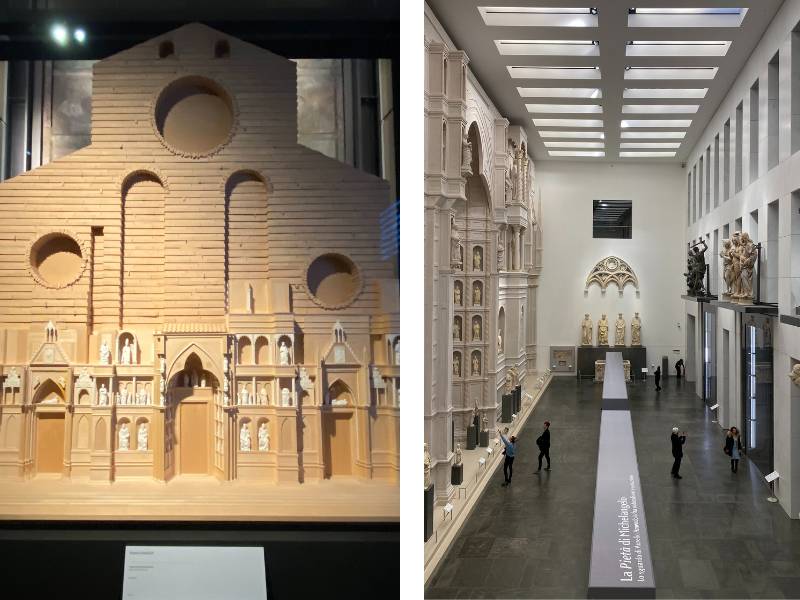
The cathedral’s facade has undergone three significant transformations over six centuries. The version we see today at the Florence Duomo Museum is a 1:1 scale replica of the original 14th-century medieval facade.
During the 16th century, the Grand Duke ordered the demolition of the medieval decorations on the facade, commissioning a new face reflecting the “mannerist” taste of the time. However, discussions about reconstructing the facade persisted for over a century.
In the 17th century, a large wall painting was created to temporarily adorn the Cathedral’s front for a royal wedding. This painting endured until the 19th century when the current neo-gothic facade was finally completed, taking the painting’s place as the new face of the Duomo.
Did you know that some of the intricate marble sculptures inside the Duomo in Florence are actually replicas? The architectural elements and sculptures of prophets, saints and angels displayed within the replica at the Florence Duomo Museum are, in fact, the genuine originals!
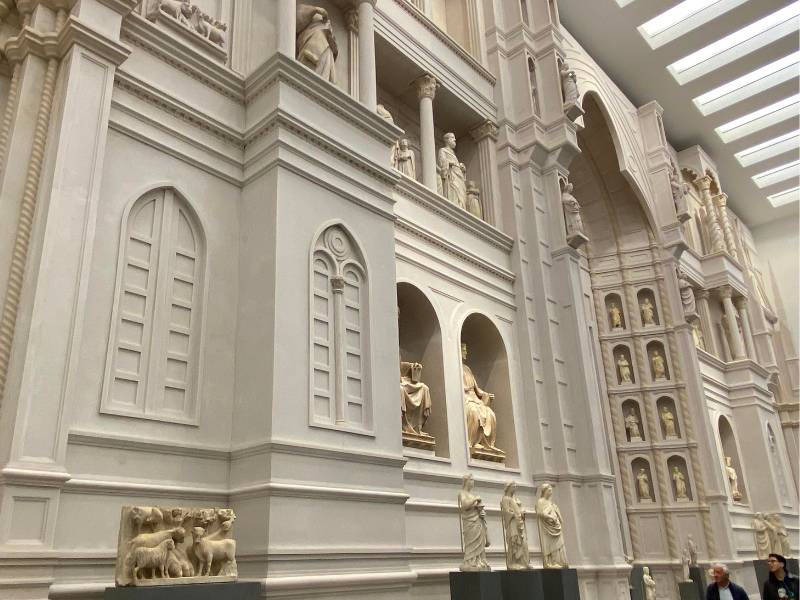
Lorenzo Ghiberti’s Gates of Paradise
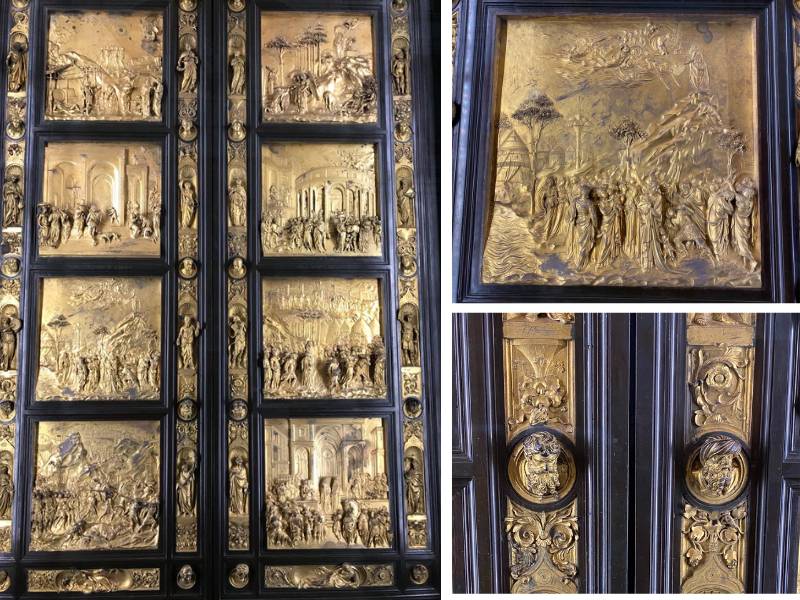
Three sets of bronze gates are displayed side by side on the ground floor, facing the original cathedral façade. These were once the actual bronze doors of the Baptistery of St. John in Florence, and are now housed in the museum for better conservation.
The middle set is the renowned Gates of Paradise, designed and built by Lorenzo Ghiberti in the early 15th century. Ghiberti dedicated over 25 years of his life to crafting this masterpiece.
The monumental and grandiose bronze door panels depict scenes from the Old Testament. If you look closer, you’ll find 24 head sculptures along the doorframes, portraying Old Testament prophets, heroines, sibyls, and even portraits of Ghiberti and his son! Can you spot Ghiberti’s head sculpture? It’s right in the center of the door!
These doors appear to be made of gold. The exquisite craftsmanship will undoubtedly leave you speechless and in awe.
Lorenzo Ghiberti’s North Gate
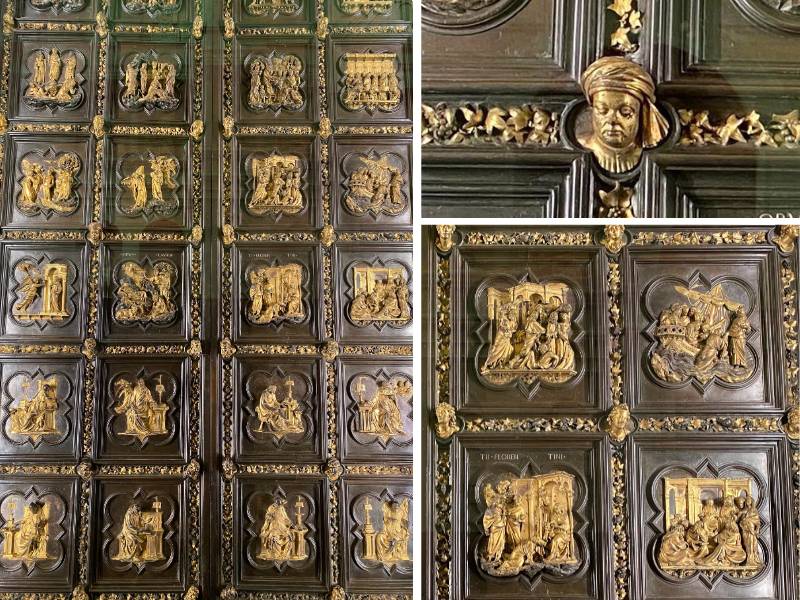
To the right of the Gates of Paradise, you’ll find the North Gate (Porta Nord), also known as the Gate of the Cross. This is another notable work by Lorenzo Ghiberti. In total, Ghiberti spent around 50 years creating these two gates for the Baptistery.
The North Gate was initially installed as the most prestigious eastern portal of the Baptistery. It was this set of doors that made Ghiberti a household name in Florence and ultimately earned him the Gates of Paradise project.
Eventually, the Gates of Paradise outshined the North Gate, replacing it as the East Gate. Consequently, the North Gate was relocated and later moved to the museum in 2015.
Similar in size to the Gates of Paradise, the North Gate weighs over 9 tons. Its 28 door panels depict scenes from the life of Jesus Christ. Notable panels include the Baptism of Christ, Jesus walking on water and saving Peter, the entry of Jesus into Jerusalem, the Last Supper, the Crucifixion and the Resurrection.
Andrea Pisano’s South Gate
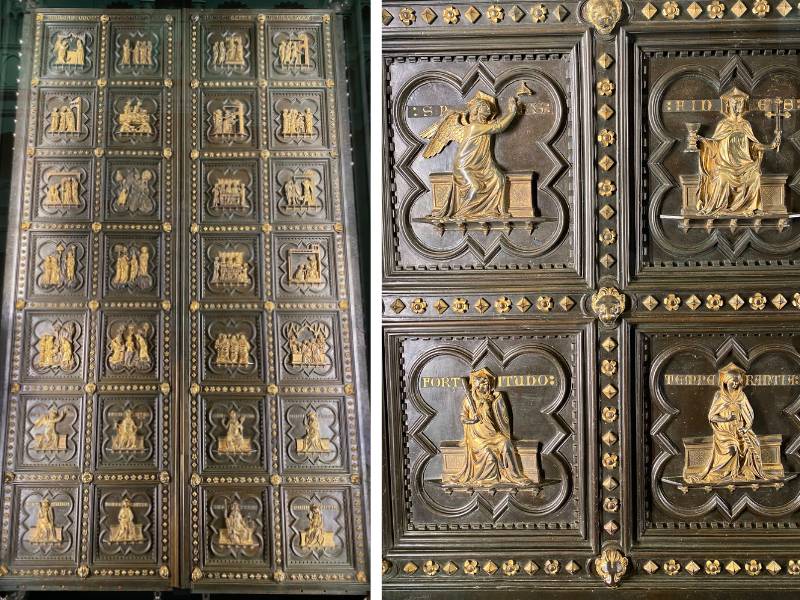
To the left of the Gates of Paradise, you’ll find the South Gate (Porta Sud), crafted by Andrea Pisano in the 14th century. This set of doors was removed from the Baptistery in 2016.
Like the North Gate, the South Gate is also framed with 28 panels. The top 20 panels depict the life of St. John the Baptist, showing scenes from his childhood to his martyrdom and burial in a clockwise direction. The bottom 8 panels portray personifications of various virtues.
Michelangelo’s Pietas
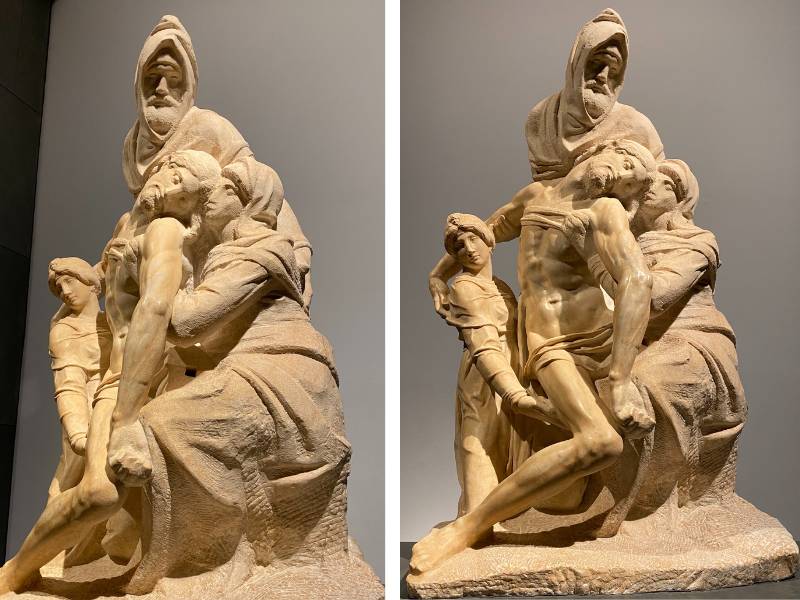
Did you know that Michelangelo sculpted three Pietàs in total? The only complete one, which he finished at the age of 24, is now preserved in Rome.
In 1980, the second Pietà sculpture by Michelangelo was removed from the cathedral and can now be found on the ground floor in the Florence Duomo Museum.
This unfinished marble sculpture was created when Michelangelo was in his 70s, and was intended to adorn the altar near his own tomb.
The Pietà depicts a man holding Jesus’s body with two women mourning over it – his mother Mary and one of his most important disciples, Mary Magdalene.
Interestingly, the man in the sculpture was supposed to be Nicodemus, one of the men who removed Jesus’s body from the cross. As a devoted Christian, Michelangelo projected himself as Nicodemus in this sculpture. The grief and pain on the man’s face perfectly reflect his deep love for Jesus Christ.
Arnolfo di Cambio’s Madonna and Child
Now, if you look up in the middle of the cathedral’s original façade, you will stumble upon a hidden gem – the 13th century masterpiece by Arnolfo di Cambio, Madonna and Child.
In this sculpture, the Madonna and Child are depicted in a gentle and intimate pose, with the Madonna’s tender expression conveying a sense of maternal love and protection to the child Jesus in her arms.
Made of marble, the Madonna even has glass eyes to make her look more realistic. The eyes of the child Jesus, on the other hand, are blank but would have originally been painted.
If you can’t see the sculpture up close, don’t worry – there’s a replica just around the corner that you can even touch.
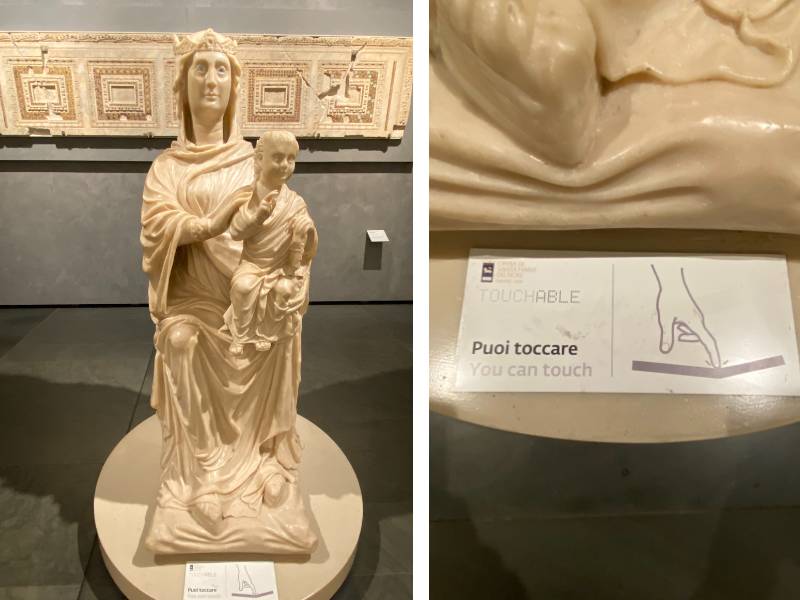
Donatello’s Mary Magdalene
The neighbor of Michelangelo’s Pietà in the museum is a life-size 15th century wood sculpture by Donatello. It depicts a penitent Mary Magdalene and was originally placed in the Baptistery.
Mary Magdalene was not only one of the important disciples of Jesus, but she was also the first person to witness his appearance after his resurrection.
When I saw this sculpture, I was struck by the miserable pose of Mary Magdalene, depicted as gaunt and haggard. At first, I thought she was covered by a broken blanket. But upon closer inspection, I realized that it was all her long hair. The sculpture conveys such sorrow and regretful emotions that you can feel them coming off it.
However, after conducting a quick online search for more information, I had mixed feelings about it.
According to the museum’s description, Christian tradition over the centuries identified Mary Magdalene with the Gospel figure of the “sinner” (a prostitute) saved and converted by Jesus. This sculpture depicts her repentance of sins (prostitution).
On the other hand, some scholars claimed that she was never a prostitute and that Pope Gregory the Great mixed her up with another Bible figure in the 6th century, and she was considered a prostitute from then on.
This paradoxical finding reminded me of the novel, The Da Vinci Code by Dan Brown, in which she was described as the wife of Jesus.
For those who do not know much about Donatello, he was the sculptor who made another masterpiece, David in bronze, which is famous for being the first freestanding piece of bronze created during the Renaissance, and is now preserved at the Bargello Museum in Florence.
Campanile gallery
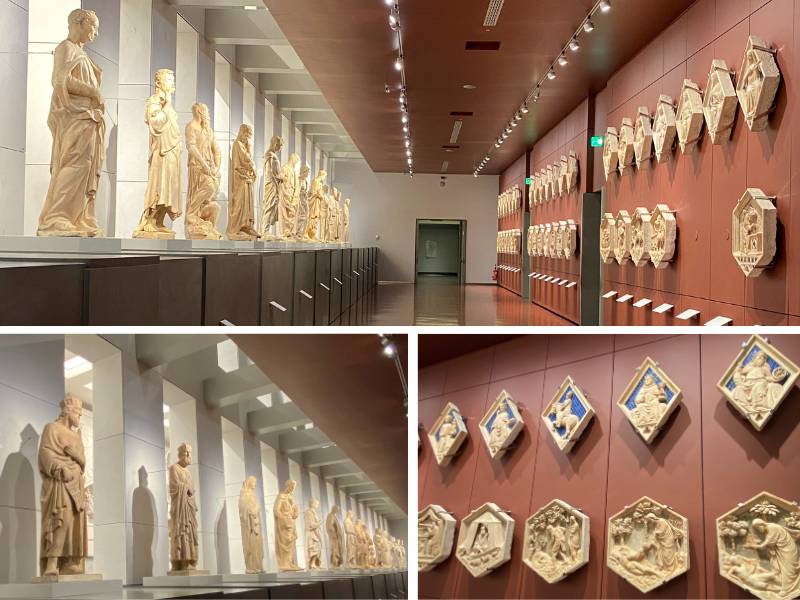
On the first floor, you can find something truly special – the original 54 reliefs and the 16 larger-than-life statues that once adorned the exterior of Giotto’s Bell Tower.
I didn’t notice how amazing those 54 reliefs were until I checked each of them up close. The creativity, sculpture technique and storytelling approach by Andrea Pisano and other artists were truly impressive.
The reliefs depict the systems structuring human life such as God creating Adam and Eve, the beginning of sheep-herding, navigation, agriculture, music, winemaking, geometry, astronomy, medicine, weaving, and more. It’s fascinating to see how these systems were represented in such a beautiful way.
I had so much fun trying to guess what the reliefs were about before checking them out on the information notes. I never thought that a man with fake eagle wings could represent the beginning of mechanical arts at that time!
As you examine the reliefs more closely, you’ll come to appreciate the remarkable attention to detail and skill involved in their creation.
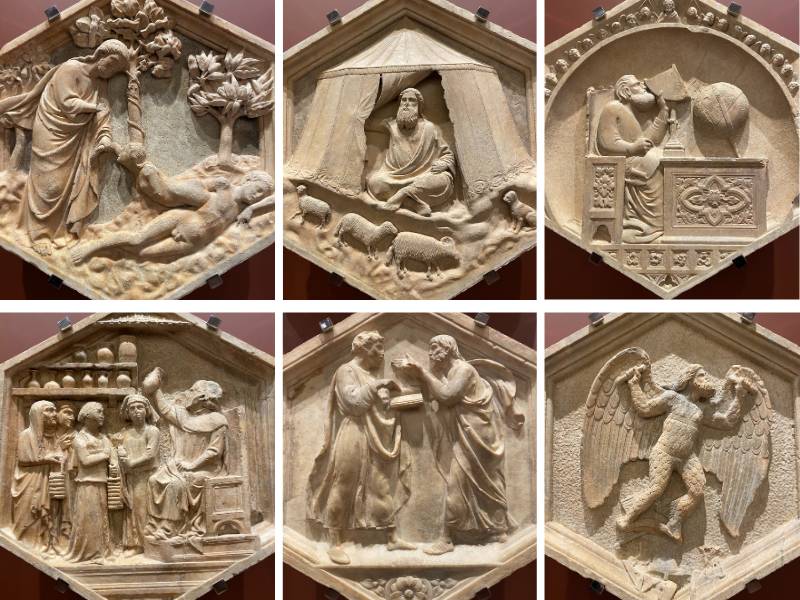
The Singing Galleries (Sala delle Cantorie) by Luca della Robbia and Donatello
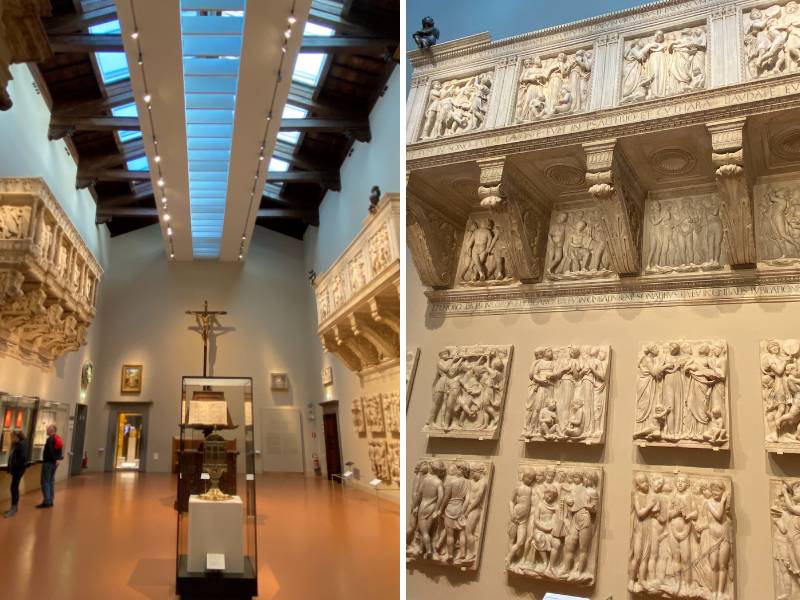
In the past, the singing galleries were set above the north-east and south-east pilasters of the crossing of the Duomo, right above the high altar.
Today, on the first floor in the Hall of Singing (Sala delle Cantorie), you can find these two original sets of marble relief sculptures created by Luca della Robbia and Donatello.
The reliefs are absolutely stunning, and it’s easy to see why they’re such an important part of the Duomo’s history. Both are richly decorated with fruit garlands, flowers and putti. They depict children joyfully singing and playing various musical instruments such as flutes and tambourines.
When you look at them, you can’t help but feel a sense of joy and wonder. They’re a beautiful testament to Florentine rich artistic and religious culture during the Renaissance.
The Duomo’s elaborate choir enclosure
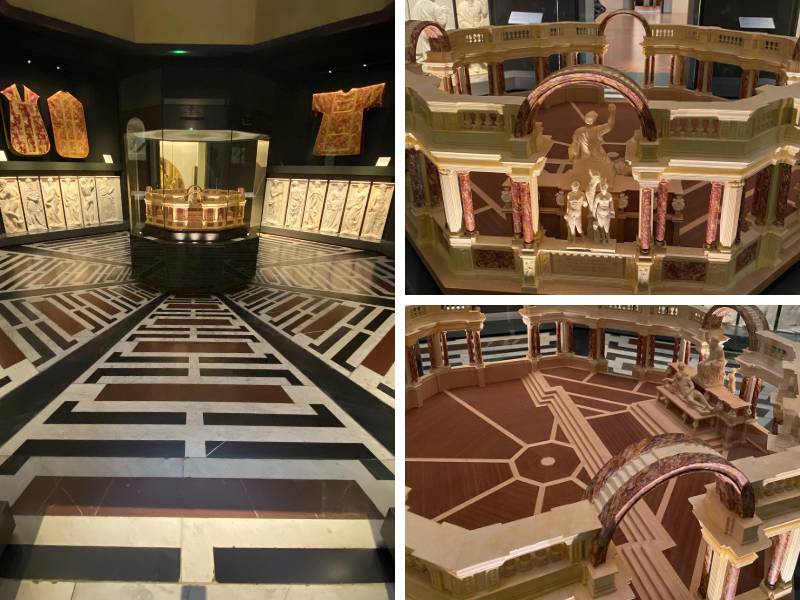
When I first saw this, I thought it was a beautifully carved Lego house. But as it turns out, it’s actually a 15th-century marble model of the Duomo’s elaborate choir enclosure, created by Giovanni Battista Caccini.
The choir enclosure served as a space for the clergy and cathedral choir to sing the liturgy in the Duomo. And this 1:25 scale model provides a unique insight into the original design and layout of the choir.
When you see the model up close, you can really appreciate the intricate details of the choir’s stalls. From the delicate carvings to the inlaid marble panels, every aspect of the design is beautifully captured in the model.
The Virgin Mary by Giovanni d’Ambrogio
If you’re visiting the first floor of the Florence Duomo Museum, be sure to check out the Sala della Navate. One of the highlights of this room is a priceless 14th-century sculpture.
This statue has an intriguing story associated with it. In 2013, an American tourist accidentally snapped off the pinky finger of the statue. It’s still a mystery whether he was trying to give the 600-year-old marble sculpture a high-five or not.
The museum promised to restore the finger, but it’s a challenging task because the finger is not from the original work but a recast. Although the story may seem funny to some, it’s actually quite infuriating for the museum.
Just a quick reminder – if you’re visiting a museum, keep your hands to yourself and enjoy the beauty from a safe distance unless you’re given permission to touch.
Cupola Gallery
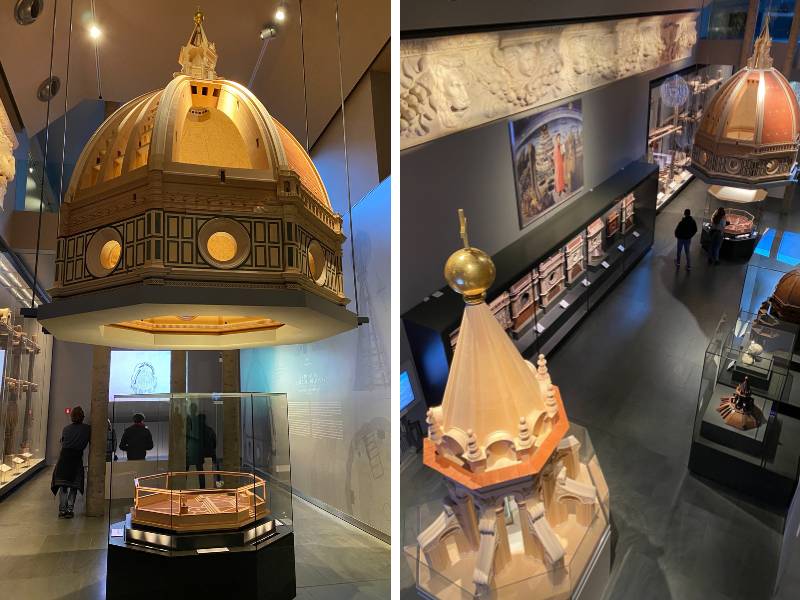
The Cupola Gallery on the first floor is dedicated to the mastermind behind the Duomo’s iconic dome – Filippo Brunelleschi.
Inside, you can see wooden models, drawings and artifacts that offer an up-close look at the intricate structure and designs of the Dome. Plus, you’ll learn about the techniques, materials and challenges involved in building the Florence Cathedral.
But that’s not all – there’s also a theater area where you can catch a short film (in either Italian or English) that explains the complex construction of the Dome. The film lasts about 20 minutes and is well worth your time.
Here’s a funny story we learned from the film: Legend has it that Brunelleschi won the competition to design the dome by challenging other competitors to place an egg upright on a table. None of them could do it, but Brunelleschi simply cracked the egg on one end and placed it on the table – and voila, it stood upright! Now that is what we call “thinking outside the shell”!
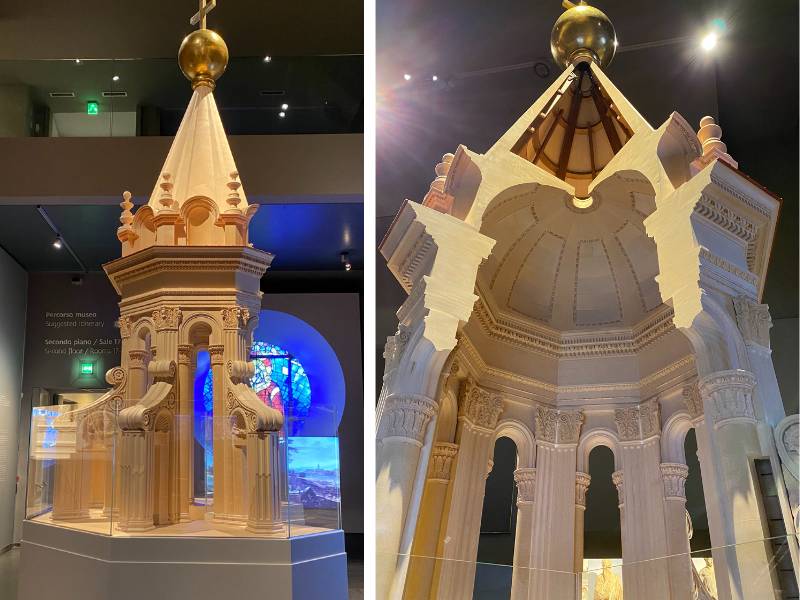
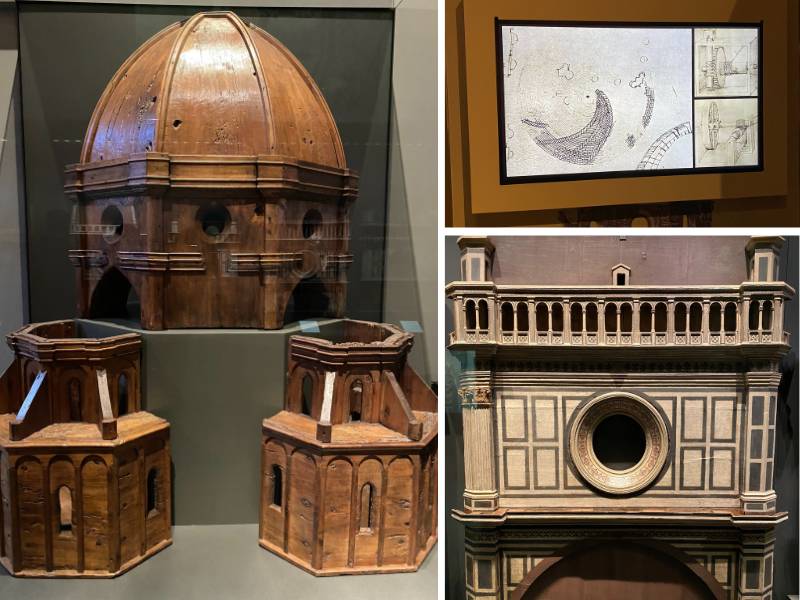
The Silver Altar of Baptistery
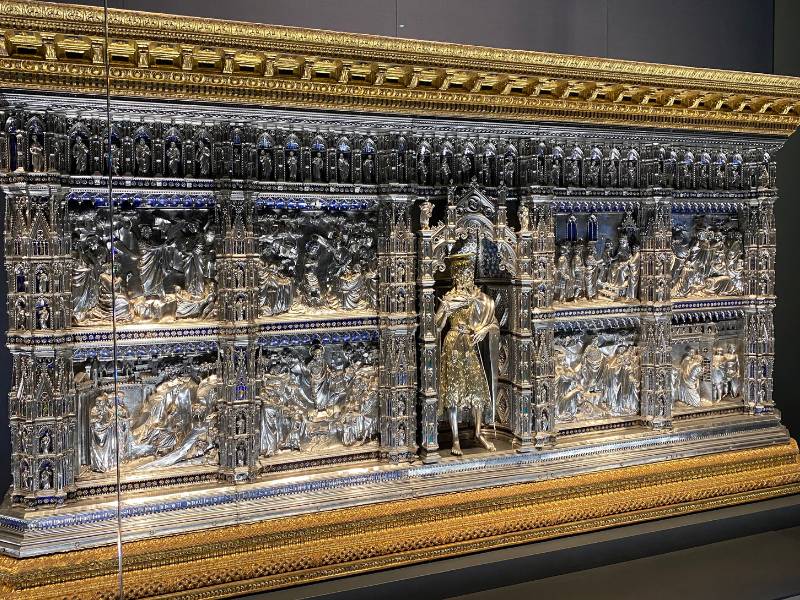
The treasury room on the first floor of the museum is home to one of the must-see exhibits: The Silver Altar, also known as The Saint John’s Treasure.
This piece was originally used to decorate a movable altar in the Baptistery, and took over 100 years to create by various renowned goldsmiths and sculptors.
The treasury is adorned with intricate silver panels depicting scenes from the life of St. John the Baptist, as well as depictions of the apostles and evangelists. With over 400kg of silver and 1050 enamelled plates, this is truly a sight to behold!
Be sure to check out the panels depicting Saint John baptizing Jesus and Saint John indicating Christ to the disciples. The Silver Altar is beyond doubt a testament to the extraordinary goldsmith techniques and sculpting of the Renaissance period in Florence.
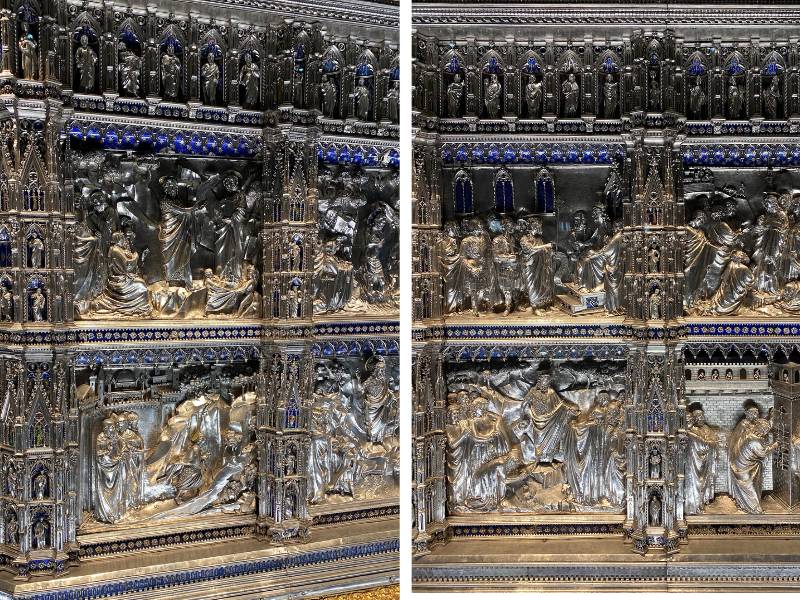
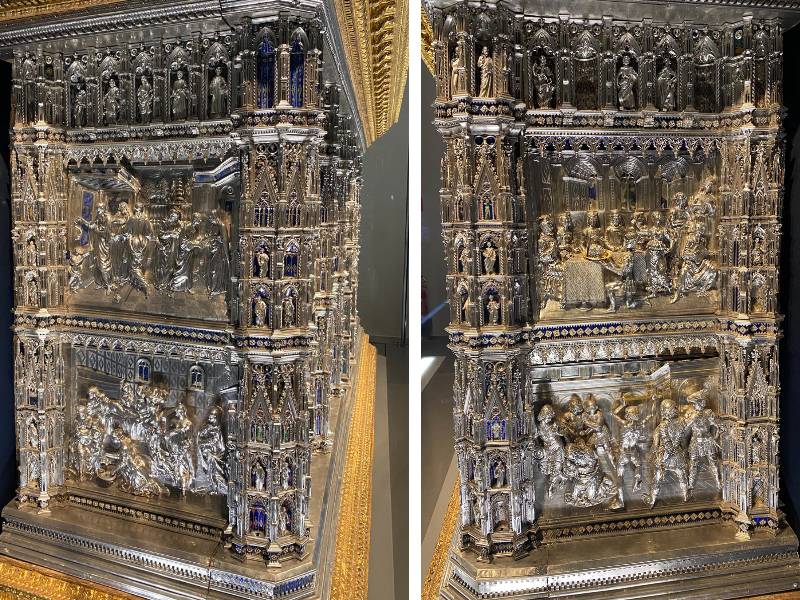
Princely projects
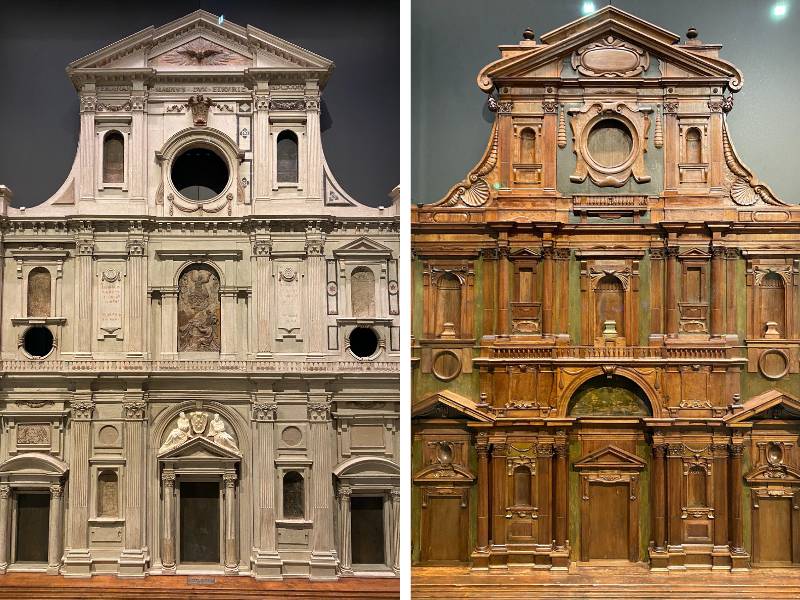
The second floor of the museum is home to a hidden gem – a project that features seven large wooden models.
These were the proposals commissioned by the Medici Grand Dukes for a Renaissance façade of the cathedral to replace the demolished Medieval ones back in the 16th century. Although none of them were chosen as the new face of the cathedral, they are still impressive works of art.
What’s really cool about this exhibit is that the museum has provided a way for visitors to compare these proposals with the reconstructed original Medieval façades seen on the ground floor. Massive floor windows in the gallery allow you to see them through the walls. It’s a thoughtful design that adds to the experience.
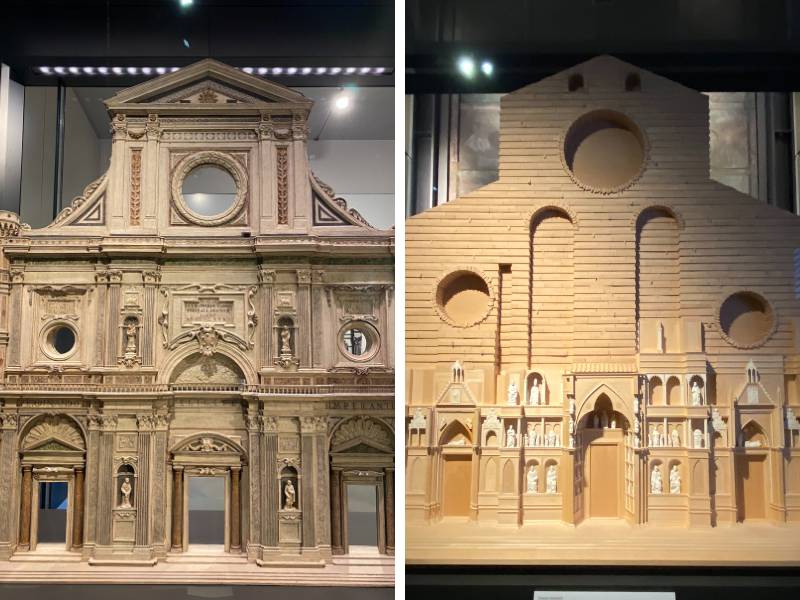
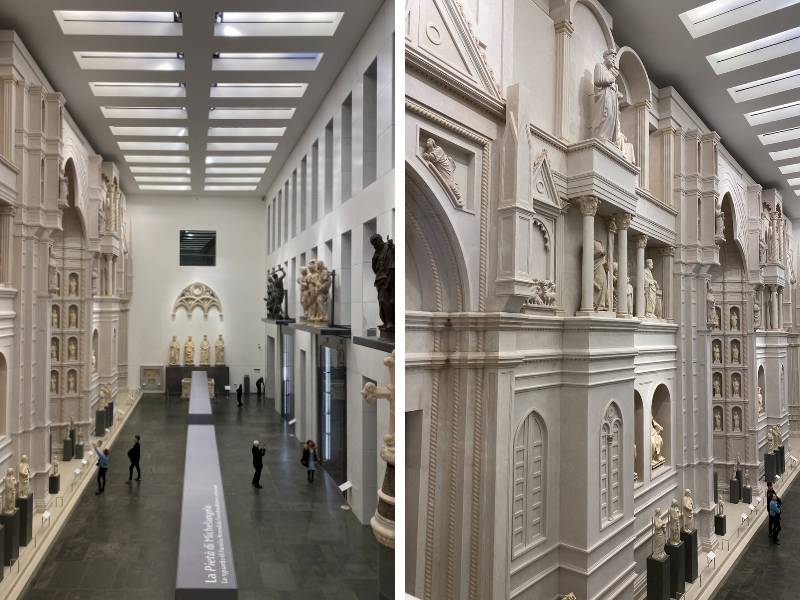
Terrace on the third floor
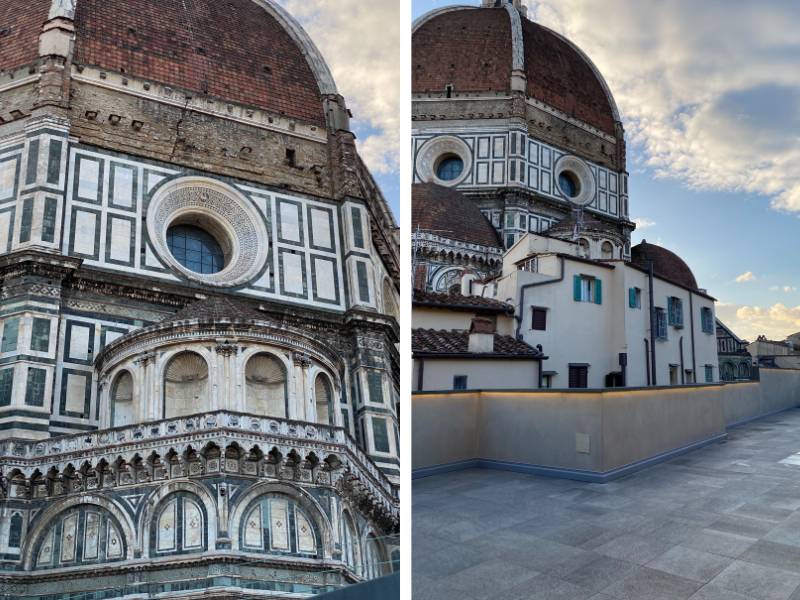
Have you ever wanted to get a closer look at the iconic Cupola of the Duomo? Well, now you can! The top floor terrace offers a unique and breath-taking view of Brunelleschi’s masterpiece.
From here, you can admire the intricate details of the dome and take in the stunning skyline of Florence. It’s the perfect way to wrap up your visit to the museum and see everything come full circle.
Florence Duomo Museum visiting tips: ticket options and purchasing
The bad news is, if you only want to visit the Duomo Museum in Florence, you can’t just stroll in and pay for entry. You’ll still need to buy a pass or a combined ticket (they bundle things up here) that includes access to other sites within the Duomo complex.
Now, there are three types of passes, ranging from €15 to €30. Or, if you prefer, you can join one of their guided tours of the Baptistery and Museum for €25. Whichever pass you get, it gives you access to the Museum anytime within their operating hours for three days from the date you booked.
You can purchase your tickets on the official website or at one of their official ticket booths located in the Duomo complex area.
There’s one right on Piazza Duomo (you can’t miss it – it’s right in front of the Florence Duomo) and another one in front of the north door of the Baptistery on Piazza San Giovanni. Just remember – the ticket booth on Piazza Duomo only accepts electronic payment.

Advice for a smooth Duomo Museum experience
The Florence Duomo Museum is open every day from 8:30 am to 7:30 pm, but make sure to avoid the first Tuesday of each month.
Now, if you’re thinking that buying a combined ticket online will save you from the long line at the Museum entrance, well, think again. While buying online can help you skip the ticket booth lines, it doesn’t necessarily mean you won’t have to wait to get in.
On my visit in November, I was lucky to find no lines. But some summer visitors have complained online about waiting for a long while, even though they had purchased their tickets in advance.
So, if you want to make sure you skip the line, consider joining one of their guided tours. Or, try visiting during the off-season or later in the afternoon (after 2pm) for fewer crowds.
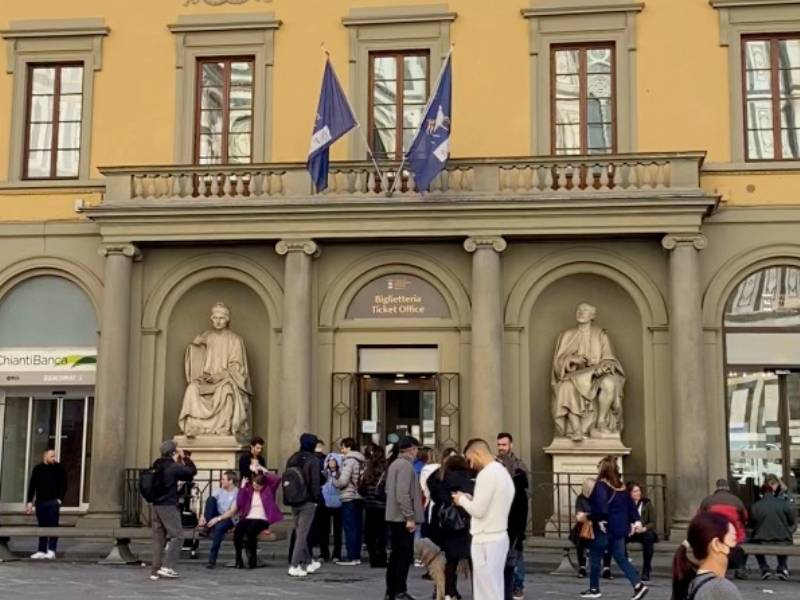
Conclusion
The Florence Duomo Museum is a must-visit for anyone mesmerized by the extraordinary artistic architecture of the Duomo in Florence.
This treasure trove houses amazing art and rare artifacts spanning seven centuries from the Medieval period to the Renaissance.
Must-see highlights include the cathedral’s original façade, Lorenzo Ghiberti’s Gates of Paradise, Michelangelo’s Pieta and the Silver Altar of Baptistery. The Cupola Gallery and singing galleries shouldn’t be missed, as they offer an up-close look at the intricate designs and techniques involved in crafting some of the Duomo’s most iconic features.
When planning your visit, keep in mind that a combined ticket is required to access the museum. To make the most of your experience, consider joining a guided tour or visiting during the off-season or later in the day to dodge the crowds.
No matter whether you’re an art connoisseur or history fanatic, you’re bound to be left in awe by the remarkable exhibits and captivating presentations that bring to life the wonders of Florence’s artistic heritage.

Kyra154
Friday 18th of July 2025
Start sharing our link and start earning today! https://shorturl.fm/Jldon
Bentley4257
Friday 18th of July 2025
Apply now and receive dedicated support for affiliates! https://shorturl.fm/XmV5u
create a binance account
Friday 18th of July 2025
Your article helped me a lot, is there any more related content? Thanks!
Cayden2830
Friday 18th of July 2025
Earn big by sharing our offers—become an affiliate today! https://shorturl.fm/waRNM
Lyla3247
Friday 18th of July 2025
Refer and earn up to 50% commission—join now! https://shorturl.fm/LRmH4